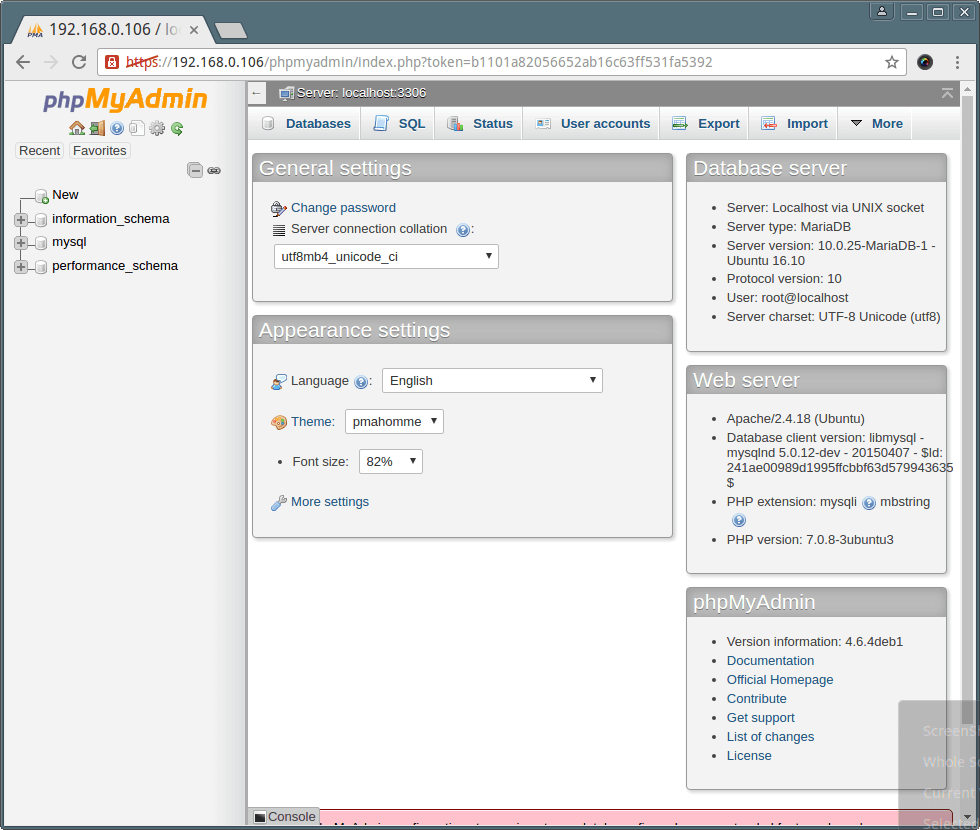
Test out your site and restart Apache the Bitnami way, rather than shutting down the VM on Google Compute Engine. Only Bitnami’s Apache should be running now.

sudo systemctl stop rvice sudo service apache2 stop You can use either commands to stop the Apache2 Service. We will fix the Bitnami white screen error by simply forcing the other Apache service to stop. This throws an error and can cause your Bitnami WordPress (or other apps) to white screen. The other Apache 2 service can automatically start if you restart a Google VM (virtual machine). sudo /opt/bitnami/ctlscript.sh restart Fix Bitnami white screen after restarting VM server Restart PHP-FPM the Bitnami way sudo /opt/bitnami/ctlscript.sh restart php-fpm
RESTART PHPMYADMIN UBUNTU INSTALL
sudo apt-get install mysql-server-5. Still if 'apache is running and not mySQL' ,then try re-installing mySQL too. Restart MySQL the Bitnami way sudo /opt/bitnami/ctlscript.sh restart mysql Consider removing phpMyAdmin completely and then re-installing it. Restart Apache the Bitnami way sudo /opt/bitnami/ctlscript.sh restart apache Do one at a time or just the one you need to restart. We will need to run commands to restart the Bitnami services. It will inform you about the scheduled reboot: rootlearnubuntu: shutdown -r 20:00 Reboot scheduled for Mon 20:00:00 UTC, use shutdown -c to. To restart the server automatically at 20:00 hours (in local system time): sudo shutdown -r 20:00. Let’s do it the safe way by SSH’ing into your GCP VM. To restart the server automatically after 30 minutes from now, use: sudo shutdown -r +30. Restarting MySQL using systemctl command, using service command and init.d are.
RESTART PHPMYADMIN UBUNTU HOW TO
Prerequisites You need an Ubuntu 14.04 server that is configured with a static IP address. This article explains how to restart MySQL in Ubuntu using various methods. The steps to install phpMyAdmin on Ubuntu 20.04 are quite similar. You could run into a Bitnami error screen (which you can fix by reading the bottom of the post.) Let’s restart Bitnami services This document will help you install phpMyAdmin and describe some basic steps to take in order to secure it. Note: Keep in mind that it’s bad practice to shutdown and restart the entire VM. For reference, I’m running Bitnami WordPress on Google Cloud Compute Engine. Don’t worry if you got Page Not found so then you have to do the extra step to set up phpmyadmin under Apache manually.Ĭopy past the following line in the bottom of the apache2.You may have edited some config files for Apache, PHP-FPM, phpMyAdmin or MySQL, and now it’s time to restart for the changes to take affect. Once the setup is completed you can go to the management consoleġ0. So that is why we need to install phpMyAdmin console.Ĩ. Now you have completely setup the LAMP server but you don’t have nice management console to access the MySql Database.


Then past the following command on it and saveħ. so you can open the following file on terminal Now you need to verify the php whether its working properly. so go to terminal and follow the command.Ĥ. After adding the line, you must restart the Apache server and open the URL, and phpMyAdmin will work. In this article easiest method explained to Install phpMyAdmin. First you have to install the “ tasksel” on Ubuntu. Install phpMyAdmin on Ubuntu 20.04 or in other OS versions with the latest Apache webserver and PHP. If your mySQL service is named something else like mysqld you may have to change the command accordingly or try this: sudo. containername: phpmyadmin environment: - PMAARBITRARY1 restart: always. sudo service mysql restart should do the job. Securing setup script, see Setup script on Debian, Ubuntu and derivatives. This should provide you with shell access to the Ubuntu server.
RESTART PHPMYADMIN UBUNTU UPDATE
Most people doing software development on linux and they need to install the LAMP on there machines so these are the steps to achieve above task.ġ. Using the proper credentials and ip address, ssh root128.0.0.1. sudo apt update & sudo apt upgrade sudo apt install wget nano sudo apt install apache2 sudo systemctl enable apache2 sudo systemctl restart.


 0 kommentar(er)
0 kommentar(er)
